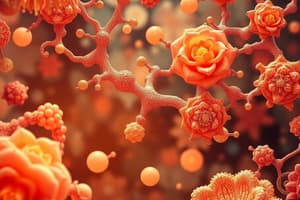Podcast
Questions and Answers
What are enzymes?
What are enzymes?
Biological catalysts that speed up biochemical reactions without being changed.
Which of the following is true about enzymes?
Which of the following is true about enzymes?
- Enzymes typically function at very high temperatures.
- Most enzymes are carbohydrates.
- Enzymes are specific due to their active sites. (correct)
- Enzymes do not require a specific pH for activity.
Enzymes are consumed in the reactions they catalyze.
Enzymes are consumed in the reactions they catalyze.
False (B)
What is an active site?
What is an active site?
Define a substrate in the context of enzyme activity.
Define a substrate in the context of enzyme activity.
What is a coenzyme?
What is a coenzyme?
What does the term 'holoenzyme' refer to?
What does the term 'holoenzyme' refer to?
What model describes how substrates fit into enzymes?
What model describes how substrates fit into enzymes?
What role do metal ions have in enzyme function?
What role do metal ions have in enzyme function?
______ are enzymes that catalyze bond cleavages by reaction with water.
______ are enzymes that catalyze bond cleavages by reaction with water.
Flashcards are hidden until you start studying
Study Notes
Enzymes and Catalysts
- Enzymes are biological catalysts that accelerate biochemical reactions within living organisms.
- Catalysts increase reaction rates without undergoing permanent changes themselves.
- Enzymes play critical roles in respiration, digestion, muscle and nerve function.
Enzyme Properties
- Most enzymes are protein molecules, constructed from chains of amino acids.
- Enzyme-catalyzed reactions typically occur under mild conditions, well below 100°C and at neutral pH.
- Enzymes exhibit specificity due to the shape of their active sites, which bind to specific substrates.
Enzyme Components
- Active site: The region of an enzyme responsible for binding to a substrate and catalyzing a reaction.
- Substrate: The molecule upon which an enzyme acts, serving as the starting material for a chemical reaction.
- Enzyme-substrate complex: A temporary intermediate formed when an enzyme binds to its substrate.
- Product: The molecule produced at the end of a chemical reaction catalyzed by an enzyme.
Enzyme Structure and Components
- Apoenzyme (apoprotein): The protein component of an enzyme requiring a cofactor for activity.
- Holoenzyme: The complete, active enzyme consisting of an apoenzyme and its cofactor(s).
- Cofactors: "Helper molecules" (inorganic or organic) that aid enzyme catalysis.
Types of Cofactors
- Prosthetic groups: Tightly bound cofactors essential for enzyme activity. Examples include heme.
- Coenzymes: Cofactors that bind to an enzyme only during catalysis, detaching afterwards. NAD+ is a common coenzyme.
- Metal ions: Essential for certain enzyme activities, contributing to catalysis by attracting or donating electrons. Metalloenzymes contain metal ions as cofactors.
Enzyme Specificity Models
- Lock-and-key model: The enzyme and substrate have complementary shapes, fitting together like a key in a lock.
- Induced fit model: The active site of the enzyme adapts its shape to perfectly fit the substrate upon binding.
Enzyme Classes
- Oxidoreductases: Catalyze electron transfer between molecules, facilitating oxidation and reduction reactions.
- Transferases: Transfer functional groups (e.g., hydroxyl, amino) between molecules.
- Hydrolases: Catalyze the cleavage of bonds using water, often involved in digestion. Examples include amylase, lipase and protease.
- Isomerases: Catalyze structural rearrangements within a single molecule, creating isomers.
Studying That Suits You
Use AI to generate personalized quizzes and flashcards to suit your learning preferences.




